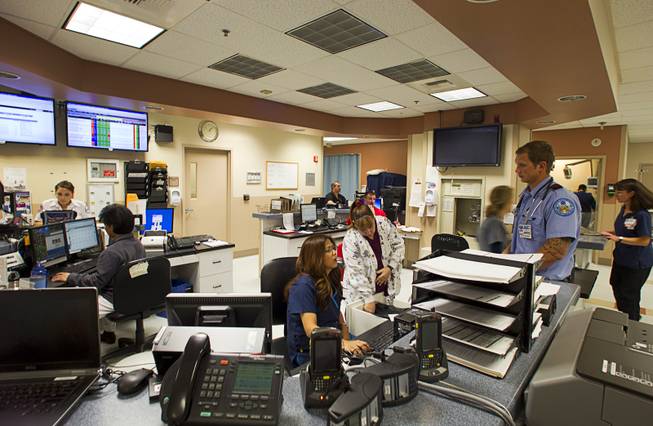
The emergency room nurse’s station is shown at University Medical Center Wednesday, Oct. 8, 2014.
Saturday, Jan. 9, 2016 | 2 a.m.
University Medical Center and St. Rose Dominican Hospital-Siena Campus declared “internal disasters” this week after patients swamped the emergency rooms, officials said.
What that means: Ambulance carrying patients who were suffering from nonlife-threatening conditions were diverted to other emergency rooms. The hospitals continued accepting patients who brought themselves to the emergency room and ambulances carrying people whose lives were in danger.
“It was kind of mellow for New Year’s Eve, but since then it has just been really, really, really busy,” said Katie Ryan, director of emergency services at UMC.
The county-run hospital’s adult emergency department was receiving 10 to 20 patients per hour — up to twice the normal volume — for long stretches on Tuesday, Wednesday and Thursday, Ryan said. The patients — many with respiratory illnesses or conditions aggravated by the cold weather — were sicker and being admitted, causing the hospital to run out of bed space.
St. Rose Dominican Hospital-Siena Campus experienced similar high patient volume, although it wasn’t driven by a single illness, a hospital spokeswoman said. Sunrise Hospital and Medical Center, MountainView Hospital and Southern Hills Hospital have been busy as well, but they haven’t needed to divert ambulances, a hospital executive said.
The Valley Health System, which includes Valley, Centennial Hills, Summerlin, Spring Valley and Desert Springs hospitals, declined to comment for this story.
The uptick in patient volume isn’t unusual. Emergency room activity tends to pick up in January and February as flu-related conditions increase in Southern Nevada, officials said. The Southern Nevada Health District has received reports of six flu-related deaths — five adults and one child — since flu season began in the fall.
When UMC enters “internal disaster” mode, hospital staff reassess every two hours or sooner to determine if they can begin accepting all ambulances again, Ryan said.
“Our goal is to get open as fast as we can,” she said.
Health District officials said most healthy people don’t need to visit a doctor if they develop the flu, an illness that generally goes away in seven to 10 days. People at higher risk for flu complications include infants, children, seniors and those with chronic health conditions. The Health District offers advice for when to see a doctor on its website.

Join the Discussion:
Check this out for a full explanation of our conversion to the LiveFyre commenting system and instructions on how to sign up for an account.
Full comments policy